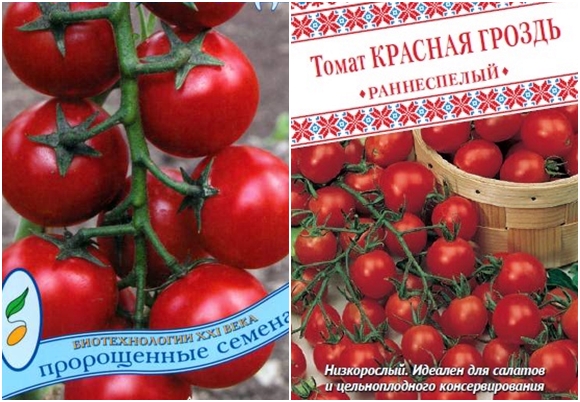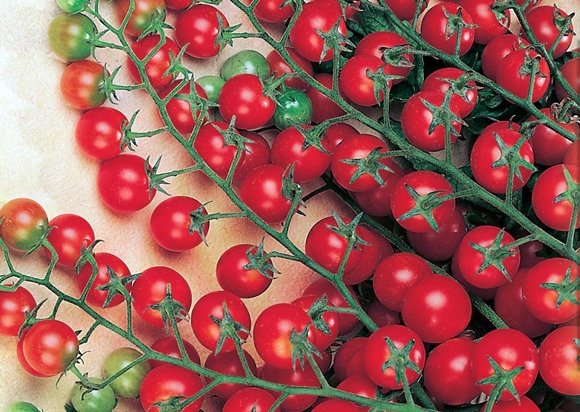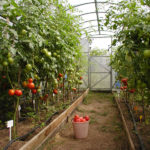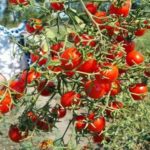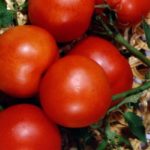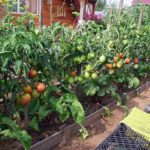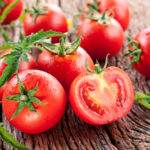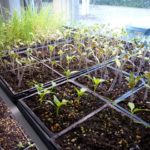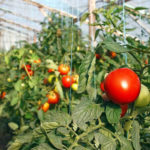The Red Bunch tomato (sometimes sold under the name Sweet Million) is a very productive and unpretentious variety. It is loved by many domestic gardeners for its versatility of use and excellent taste of the fruit.
Description of the tomato variety Red Bunch
The Red Bunch tomato variety was developed by the Russian agricultural company Agroni. It was registered in the state register for cultivation in open ground and greenhouses in 2008.
Before purchasing planting material, it is important to study the description of the tomato.This will help ensure whether the variety is suitable or not.
The plant belongs to the determinants, the growth of the bush is limited, the height of the main stem does not exceed 50-60 cm. The stem is thick, the top must be pinched so that the bush grows wider. It is distinguished by the formation of a large number of brushes strewn with tomatoes.
The tops are emerald green, “potato” in appearance, not pubescent. The inflorescence of the Red Bunch variety is simple. The first inflorescence begins to form after 6-7 leaves. Next - after 1 - 2 sheets.
The root system of the tomato is powerful and grows strongly in different directions.
The main characteristic is immunity to diseases of nightshade crops such as powdery mildew. Reviews from some gardeners who grew the Red Bunch variety indicate that when there are strong drafts when grown in a greenhouse, plants may be subject to late blight.
High resistance to sudden temperature changes. Fruiting continues throughout the season. Suitable for growing on a balcony or glassed-in loggia.
Fruit characteristics
Red Bunch tomatoes are early ripening varieties. The harvest can be harvested 90–100 days after the first shoots appear.
A lot of brushes form on the tomato. On the first few clusters, 40-55 fruits are formed, then 20-30. Productivity is good.
The tomatoes are not large, about 40 grams. The shape of the fruit is oval. The pulp is juicy, tender, with a pleasant tomato aroma. The skin is smooth, not ridged, and quite dense. Unripe fruits are light green in color; as they ripen, they acquire a bright red hue; there is a small green spot near the stalk.
Vegetables produce a small amount of seeds and contain a minimal amount of dry matter.Tomatoes of the Red Bunch variety are suitable for preparing salads, eating fresh, and canning as a whole. You can use them to prepare delicious tomato juices, lecho and adjika.
Advantages and disadvantages of tomatoes
Reviews from those farmers who planted tomatoes on their plots are extremely positive. But, despite the fact that the variety has a large number of advantages, it has a number of disadvantages.
Advantages:
- Abundant fruiting throughout the season (more than 10 kg of fruit can be collected from a bush);
- Friendly and early ripening of fruits;
- You can collect vegetables until October;
- High taste of vegetables;
- No pinching required;
- The fruits do not crack and can be stored for a long time;
- Universal use in cooking;
- Can be grown in open and closed ground.
Flaws:
- In the northern regions, cultivation is possible only in greenhouse conditions;
- In strong drafts, bushes may suffer from late blight.
In general, no significant deficiencies were found in the tomato.
How to grow Red Bunch tomatoes
The process of planting Red Bunch cherry tomatoes is the same as for regular tomatoes. Sowing of seeds begins on the 20th of February. First of all, planting material must be disinfected in a solution of potassium permanganate. Then they need to be dried and planted to a depth of 2 - 3 cm. The distance between the seeds should be at least 1 cm.
All varieties of cherry tomatoes need to be picked. They do not tolerate crowded conditions well and may not grow well in such conditions. You need to dive when the first 3–4 leaves appear.
Peat cups can be used for this purpose. In order not to injure the seedlings, they can be transplanted to a permanent place in these cups.
The place for planting seedlings should be well lit.If tomatoes don't get enough sunlight, they will begin to grow poorly and get sick. Seedlings should be planted on fertile, oxygen-saturated soils. The distance between bushes should be at least 40 cm.
To increase productivity throughout the season, mineral and organic fertilizers must be applied to tomatoes. The first fertilizing is applied during the formation of ovaries. For 1 kg of manure (you can take chicken manure or mullein) you need 10 liters of water. The bushes need to be watered with this solution for 2 – 3 weeks.
The second feeding is carried out during the fruiting period. You need to take 10 liters of warm water, 1 kg of green grass or manure and 1 tbsp. l. any mineral fertilizer for tomatoes.
It is recommended to carry out foliar feeding, alternating them with root feeding. In the first half of the season, the bushes can be sprayed with a urea solution (1 tablespoon of urea and 1 gram of potassium permanganate diluted with 10 liters of warm water).
During the fruiting period, plants must be treated with a solution of potassium sulfate, potassium nitrite or potassium magnesium (1 tablespoon of fertilizer is diluted in 10 liters of warm water).

